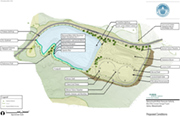FOR IMMEDIATE RELEASE: October 5 , 2005
CONTACT: Ria Convery, (617) 788-1105 or ria.convery@mwra.state.ma.us
FACTS ABOUT MWRA’S BLUE HILLS COVERED STORAGE PROJECT
|
Background
DEP safe drinking water regulations require that distribution storage facilities be covered to protect the quality of treated drinking water. MWRA has embarked on a system-wide program to eliminate open distribution storage reservoirs from active service and replace them with secure covered tanks.
Two 10 million-gallon buried drinking water storage tanks are proposed to be constructed in the east end of the existing Blue Hills reservoir. These tanks are critical to the MWRA’s Southern High water service area, which would be served by the proposed covered tanks. It is one of the only remaining areas in the MWRA system that has no significant distribution storage to ensure a safe and reliable public water supply.
The Project
The new water storage tanks will be filled with MWRA drinking water and will serve Quincy, Milton, Brookline, Roxbury, West Roxbury, Jamaica Plain, Roslindale, Mattapan and Hyde Park. The water tanks will store safe drinking water for consumption and fire protection in the event of a pipeline break or other water supply emergency.
Since the events of September 11, 2001, MWRA has become more security conscious and has increased the priority of constructing this and other covered storage projects. In November 2001, legislation was filed to accelerate the project by allowing MWRA to use the design/build process to construct this facility. It was enacted in September 2002.
The existing reservoir was constructed in 1950s and was removed from active service in 1981 due to contamination from birds and animals. The reservoir is currently used as a non-potable emergency supply.
The project cost is estimated to be $32 million including $8 million for site enhancements and wetlands mitigation. Bids are expected in Spring 2006 and construction should take approximately 2 years.
The Blue Hills Working Group was formed in 1997 to review alternatives and met periodically for 3-1/2 years to provide input to MWRA. The Working Group includes representatives from the Department of Conservation and Recreation, Quincy, Milton, Braintree, Trailside Museum, Friends of Blue Hills, Water Supply Citizens Advisory Committee, MWRA Advisory Board, and St. Moritz Stables.
The proposed alternative was selected because the site:
- Is at the proper elevation to supply adequate water pressure
- Minimizes impacts to upland endangered species habitat and park land
- Limits most of the impacts to previously disturbed land within the man-made drinking water reservoir
- Continues the use of the site as water supply, and it provides the opportunity to repair and improve the deteriorating dam, diversify wetland habitat, and expand parks and recreation use into an area that is currently closed to public use.
Environmental Mitigation
MWRA has worked closely with various interested parties to include features that will mitigate environmental impacts and improve the look of the finished site (link to site plan):
- The tanks will be buried and meadow will be planted on top
- Much of the existing deteriorating dam will be removed and replaced with a new dam with grassed slopes
- The remaining half of the reservoir will be restored and wetlands will be created and enhanced to support wildlife habitat
- Hiking trails will be constructed around and through the site
- Public access will be expanded to areas that are presently restricted
Taken all together, MWRA’s proposed mitigation has increased the project cost by 30% making this project the most costly covered storage project per gallon of water undertaken by the MWRA.
This project is part of MWRA's Integrated Water Improvement Program.
###
PDF files on this website require Adobe Acrobat Reader. Click here to download a a free copy.


